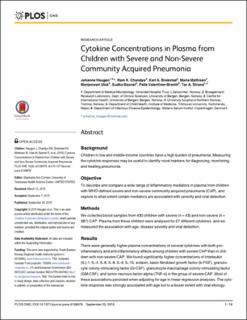| dc.description.abstract | Background: Children in low and middle-income countries have a high burden of pneumonia. Measuring the cytokine responses may be useful to identify novel markers for diagnosing, monitoring, and treating pneumonia.
Objective: To describe and compare a wide range of inflammatory mediators in plasma from children with WHO-defined severe and non-severe community acquired pneumonia (CAP), and explore to what extent certain mediators are associated with severity and viral detection.
Methods: We collected blood samples from 430 children with severe (n = 43) and non-severe (n = 387) CAP. Plasma from these children were analysed for 27 different cytokines, and we measured the association with age, disease severity and viral detection.
Results: There were generally higher plasma concentrations of several cytokines with both pro-inflammatory and anti-inflammatory effects among children with severe CAP than in children with non-severe CAP. We found significantly higher concentrations of interleukin (IL)-1, IL-4, IL-6, IL-8, IL-9, IL-15, eotaxin, basic fibroblast growth factor (b-FGF), granulocyte colony-stimulating factor (G-CSF), granulocyte-macrophage colony-stimulating factor (GM-CSF), and tumor necrosis factor-alpha (TNF-α) in the group of severe CAP. Most of these associations persisted when adjusting for age in linear regression analyses. The cytokine response was strongly associated with age but to a lesser extent with viral etiology.
Conclusion: The plasma concentrations of several cytokines, both with pro-inflammatory and anti-inflammatory effects, were higher among children with severe illness. In particular G-CSF and IL-6 reflected severity and might provide complementary information on the severity of the infection. | en_US |

